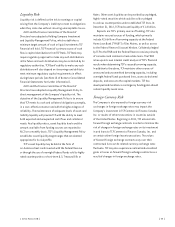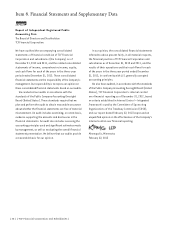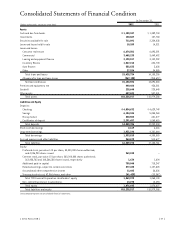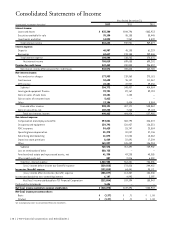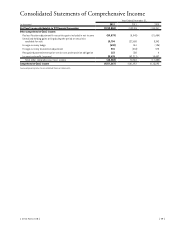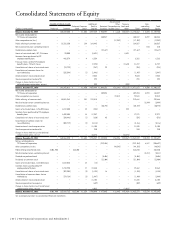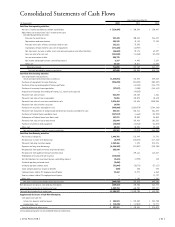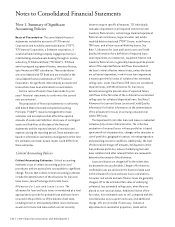TCF Bank 2012 Annual Report Download - page 81
Download and view the complete annual report
Please find page 81 of the 2012 TCF Bank annual report below. You can navigate through the pages in the report by either clicking on the pages listed below, or by using the keyword search tool below to find specific information within the annual report.Loans and leases, including loans considered impaired,
are reviewed regularly by management. Consumer real estate
loans are placed on non-accrual status when the collection
of interest and principal is 150 days or more past due or
when six payments are owed. Consumer loans other than real
estate and auto loans are charged-off or written down to
collateral value less costs to sell at 120 days or more past
due or when five payments are owed. Consumer real estate
loans, consumer loans other than real estate, and auto
loans are generally placed on non-accrual status within
60 days of notification of bankruptcy, unless the customer
has a sustained period of payment performance of six months
or longer, including time prior to bankruptcy. Furthermore,
consumer real estate loans and consumer loans other than
real estate and auto loans, are permanently placed on non-
accrual status upon discharge under a Chapter 7 bankruptcy
proceeding when the borrower does not reaffirm the debt,
regardless of delinquency status.
Commercial real estate and commercial business
loans, leasing and equipment finance loans and leases and
inventory finance loans are generally placed on non-
accrual status when the collection of interest or principal
is 90 days or more past due, unless the loan or lease is
adequately collateralized and in the process of collection.
Generally, when a loan or lease is placed on non-
accrual status, uncollected interest accrued in prior years
is charged off against the allowance for loan and lease
losses and interest accrued in the current year is reversed
against interest income. For non-accrual leases that
have been funded on a non-recourse basis by third-party
financial institutions, the related liability is also placed on
non-accrual status. Interest payments received on loans
and leases in non-accrual status are generally applied to
principal unless the remaining principal balance has been
determined to be fully collectible, in which case interest
income is recognized on a cash basis. Loans on non-accrual
status are reported as non-accrual loans until there is
sustained repayment performance for six consecutive
months, with the exception of loans not reaffirmed upon
discharge under Chapter 7 bankruptcy, which remain on non-
accrual status permanently based upon regulatory guidance.
Income on these loans is recognized on a cash basis when
there is sustained repayment for six consecutive months
(which may include payments prior to bankruptcy), and the
loan is not more than 60 days delinquent.
Purchased Credit-Impaired (PCI) Loans acquired
with evidence of credit deterioration since their origination,
where it is probable TCF will not collect all contractually
required principal and interest payments, are recorded as
PCI loans. PCI loans are recorded at fair value at the date
of acquisition. Such loans are considered to be accruing
based on the existence of an accretable yield and not
based on consideration given to contractual interest
payments. The excess of expected cash flows to be
collected over the initial fair value of an acquired portfolio
is referred to as the accretable yield and is accreted into
interest income over the estimated life of the acquired
portfolios using the effective yield method. The difference
between the contractually required payments and the cash
flows expected to be collected at acquisition, considering
the impact of prepayments, is referred to as the non-
accretable difference.
Premises and Equipment Premises and equipment,
including leasehold improvements, are carried at cost and
are depreciated or amortized on a straight-line basis over
estimated useful lives of owned assets and for leasehold
improvements over the estimated useful life of the related
asset or the lease term, whichever is shorter. Maintenance
and repairs are charged to expense as incurred. Rent
expense for leased land with facilities is recognized in
occupancy and equipment expense. Rent expense for
leases with free rent periods or scheduled rent increases
is recognized on a straight-line basis over the lease term.
Other Real Estate Owned and Repossessed and
Returned Assets Assets acquired through foreclosure,
repossession or returned to TCF are initially recorded at
the lower of the loan or lease carrying amount or fair
value of the collateral less estimated selling costs at
the time of transfer to real estate owned or repossessed
and returned assets. The fair value of other real estate
owned is determined through independent third-party
appraisals, automated valuation methods or real estate
broker’s price opinions less estimated selling costs. The
fair value of repossessed and returned assets is based on
available pricing guides, auction results or price opinions
less estimated selling costs. Within 90 days or four months
of a loan or lease transferring to other real estate owned
or repossessed and returned assets, any carrying amount
in excess of the fair value less estimated selling costs is
charged off to the allowance for loan and lease losses.
Subsequently, if the fair value of an asset, less the
{ 2012 Form 10K } { 65 }


